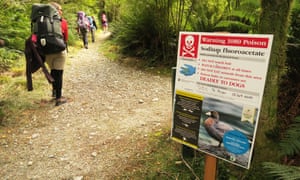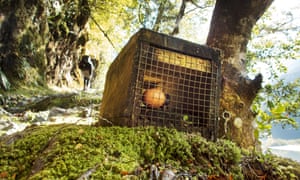Surrounded by ancient rimu trees and the sound of chirping piwakawaka, Tame Malcolm brings in his second rat of the day from the dense undergrowth of his Auckland backyard. That’s four pests for his tally today – with only a few hundred thousand or so to go.
“It’s the first time my whanau [family] have got to see me doing pest control. I’ve been teaching the whanau that we do this to protect the birds,” says Malcolm, director of Maori-oriented biosecurity business Puna Consultants.
For Maori, many of these threatened birds are classed as taonga; a natural treasure with special significance to the culture. “These taonga species are part of our whakapapa [genealogical ties]. They helped protect our tupuna [ancestors] so we have a duty to help them.”
As the autumn leaves fall and crackle, Malcolm would usually be out assisting iwi [tribes] around the country with urgent pest control measures, with a particular focus on exterminating rats as the winter months loom.
Now, like every other New Zealander, Malcolm is stuck at home in the third week of level-four lockdown. Pest control has been deemed a non-essential service by the government; a decision experts say is putting New Zealand’s most vulnerable wildlife at risk, as the number of rats, mice and stoats surges.
The timing couldn’t be better for New Zealand’s vermin. They’re coming off 2019’s “mega mast” year, which means bountiful supplies of seed allowed their populations to flourish. Now, with vital pest control efforts halted, there are growing public health concerns as vermin colonise urban areas unchallenged.
It also makes the government’s goal to wipe out all pests by 2050 increasingly elusive. The ambitious project aims to restore the country to its pre-human state, a time before introduced pests were able to wreak havoc on its natural biodiversity.

Arriving as hitchhikers on settler boats from the 13th century onwards, invasive animals such as rats made easy work of vulnerable bird populations, including the iconic flightless Kiwi which once numbered in the many millions but today languishes below 70,000.
Even with the Department of Conservation’s extensive trapping, baiting, and aerial poison drops, 68,000 native birds fall victim to invasive predators every day. As most of these species are endemic to New Zealand, a population wipe-out would mean complete extinction.
Heading home for dinner
Rats are the most challenging of all of these predators to manage, with their penchant for swimming, year-round breeding and huge litters. Autumn cooling into winter also means rats are getting cold – and heading indoors.
“Food’s running short which means juvenile pests are spreading out to find a new source of food,” says Kevin Hackett, chief conservationist at conservation organisation Forest & Bird.
For many hungry vermin their new source of food will come from urban areas and homes, where food is more easily accessible. With restaurants, cafes and takeaways no longer producing the goods, that leaves famished rats one option for dinner – homes.
“It’s pretty amazing how many rats are showing up near me and how damn big they are,” says Auckland resident Mikaela Street. “My cat Maurice is arriving at the doorstep with a long-tailed gift most mornings these days.”
The majority of this urban trapping is usually managed by volunteer community groups, but with lockdown restrictions in place, Kiwis have been forced to turn their own hands to keeping rats at bay. In fact, the lockdown has given hunters who are banned from heading into the bush for “the roar” – the deer mating season – a fresh purpose.
Renamed “the squeak”, a 28,000-strong online community has blossomed in which hunter is pitted against hunter in a battle to bring in the most impressive rat – a ghoulish project that nonetheless is playing a serious role in resuscitating stalled conservation efforts.

“It’s all pretty funny actually,” says competition administrator Brett Collins. “People that would never have thought about catching mice or rats are now making a real concerted effort to get into their backyards and sheds to try and catch these mice and rats, which is going to be doing a lot for our native wildlife.”
The focus on private trapping during lockdown – and the attempt to make it fun – is proving essential to manage unchecked pest populations, says Rachel Fewster from the University of Auckland.
Data collected by a University of Auckland project, CatchIT, from 3,000 community groups around the country, indicates a huge fall in the number of rats caught during a traditionally fruitful time of year. In the past week, CatchIT registered just a third of the captures they saw over the same period in the previous two years.
Kane Kvasnicka from Restore Hibiscus and Bays, an organisation representing 30 community groups and 155km of coastline in the north of Auckland, worries that the month-long trapping hiatus may prove disastrous for their years of hard work eradicating pests.
“We have people and groups that have been out there maintaining trap lines for more than 10 years, so naturally we’re worried sick about the birds and reptiles we’re trying to save,” says Kvasnicka. “Our main effort is to try and bring about the government’s Predator Free 2050 goals, so the kind of impact this might have, especially if the Alert Four period is extended, is pretty concerning.”
Hackwell from Forest & Bird notes this pause in predatory control will be most strongly felt among the high-risk endangered species. Nesting seabirds such as the storm petrel, northern royal albatross, and the kaki are among the most vulnerable.
“A lot of projects that have been working very hard to save species and grow numbers could be under real threat at this time of year,” Hackwell says.
“Species such as titi or blue penguins are yet to fledge their young, so without the trapping that goes on, they’re very susceptible to being eaten by the likes of ferrets and stoats.”
The Department of Conservation has made arrangements for essential care if wildlife emergencies occur in conservation areas, but they note that the “threshold is high and public safety must come first”. Otherwise, the majority of their pest-eradication plans are on hold indefinitely.
For now, Kiwis must turn to their own yards to do their bit in the fight against the onslaught of rats. The dramatic shutdown is no doubt saving lives, but there are fears some precious wildlife may never recover.
“We’ve already seen localised extinctions of taonga birds like the kakariki and kaka as a result of doing nothing to stop invasive species,” says Malcolm.
“The lockdown is going to be good for our country in the long run, but at what cost?”
Find more age of extinction coverage here, and follow biodiversity reporters Phoebe Weston and Patrick Greenfield on Twitter for all the latest news and features